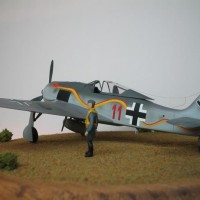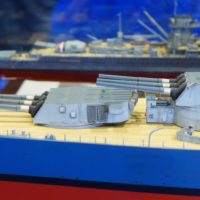AFV Club USS Kirk (Knox-class frigate)
The FF-1087 USS Kirk was a Knox-class anti-submarine warfare (ASW) frigate. The Knox class frigates were commissioned in 1969 but served only a brief 23 years, as improving ASW technology quickly made them obsolete. Frigates evolved from the destroyer escort, which were smaller, slower ships needing to keep pace with larger, slower convoys (10-12 kn). Most had relatively light armament with the primary mission of hunting and attacking submarines.
The Knox class frigates initially lacked defensive fire power, with only a single 5″ Mk 42 gun, owing to the cancellation of the RIM-46 Sea Mauler anti-aircraft missile. The Sea Sparrow was eventually installed to fill this gap, which in turn was eventually replaced by the Phalanx CIWS in the stern of the ship. Anti-submarine armament included the ASROC anti-submarine rocket, installed just ahead of the bridge, and Mark 32 torpedos. The Knox class frigates also maintained a hangar and landing pad for a small helicopter, originally an anti-submarine drone (DASH), but soon also accommodating the Kaman Seasprite.
This particular model, the USS Kirk, played an instrumental role in the evacuation of Saigon, Vietnam in Operation Frequent Wind. In addition to protecting the remainder of the South Vietnamese Navy, the USS Kirk served as the landing pad for a series of helicopters flown by fleeing South Vietnamese airmen and their families. Since the ship could only accommodate a single helicopter at a time, after debarkation the aircraft were literally shoved overboard into the sea. In one harrowing incident, a large Chinook, too large to land on the deck, simply tossed refugees out of the helicopter; the pilot then steered the CH-47 away and ditched into the ocean. All survived.
The USS Kirk, along with several other Knox-class frigates, currently serve with the Taiwanese Navy.
The Kit
The AFV Club 1/700 Knox-class frigate includes a single styrene sprue and decals. There is a “Detail-Up” version for almost $100 more (the basic kit goes for something like $20 in spring 2024), which include PE add-ons, full-hull option, and a resin wave base. Alternatively, there is a nice PE add-on available by Five Star (also for around $20) that includes railings, radars, trusswork, stairs, doors, and so on. Having grabbed the basic AFV kit on eBay, I purchased the Five Star PE and got to work:
As you can see the Five Star set comes with 3 frets of PE and a brass barrel for the 5″ gun. I also picked up the whip antennas set.
Note that AFV Club, a Taiwanese company, is not particularly known for ship models, but tanks and the like as their name suggests. They make at least one other frigate, both it and this one happen to be in service with the Taiwanese Navy which might explain this foray.
The Five Star PE set is quite extensive, but the parts are fragile: you need to get whatever folding is required right the first or second time, or else the parts will break off. Instructions comprise photographs of the assembled parts and their placement on the completed ship: while I was able to figure things out, some assemblies are a little complicated and could probably benefit from more careful step-by-step instructions. Also, not all PE parts in the photographs are identified, but this too is easy enough to resolve. One drawback of the Five Star set is the lack of goodies that adorn the main mast; these appear present in the AFV detail set.
The AFV kit provides decals for 3 US and 3 Taiwanese ships; oddly, though, for one of the ships the name doesn't match the markings (you get markings for the Aylwin but the name is McCandless). The decals are also generally of poor fit: the hazard stencil on the bottom of the helicopter hangar door is too short for the door, rendering it useless. While we get hull numbers and names appropriate to the different ships, we only get one set of stencils that are simply not accurate for all, if any actually. So, I ended up foregoing many of the more questionable markings. Also, the decals don't include any flags which is a bit of a bummer, or helopad markings.
The supplied helicopter and life raft are lacking detail and have mold imperfections. These appear crude in comparison to the detail of the PE and really cannot be used. I decided to replace the helicopter with some SSModel 3D-printed resin Seahawks, but, alas, these don't belong on Knox-class frigates. Doing without a helicopter isn't such a big deal, as virtually every photograph of Knox frigates I've seen do not have a helicopter visible on the deck.
Modern US warships are generally painted in Haze Gray (FS36270) and Deck Gray (FS36008). Vallejo Model Air offers both colors, but the Deck Gray was considerably lighter than what looks like non-skid surfaces in photographs. I therefore opted for Vallejo Model Colors Basalt Gray for most horizontal surfaces. These I painted first, then masked for subsequent work. Most subassemblies were painted before going on the model, to minimize masking. PE was mostly painted on the fret, and touched up as needed later.
I gave much of the ship a Tamiya Dark Gray enamel wash, and applied some assorted oils (rust, white, gray) to the hull to add a touch of weathering. These ships were pretty clean, so there's not much else to be done here.
In summary, this was a time-consuming, long, and challenging build. At my normal pace, this took about 4 weeks. The AFV Club kit was a bit of a disappointment, with considerable room for improvement. Corsair Armada apparently makes a Knox-class in the USS Whipple, so it might be worth checking out for anyone interested in building a Knox. But, thanks to Five Star's lovely detail set, it can be wrought into something quite nice.













Beautiful. I remember when I was first in the Navy seeing them come alongside and get their fuel topped off from our JP-5 tanks. Well done brings back great memories of seeing these sleek warships
Thanks Rob! It must have been exciting to be out and about among all those marvelous ships!
A beautiful build, Brian @bapowellphys
Seems like a great kit with all those extras.
Thanks John! The extras really make it.
Fantastic looking ship! It really looks the part.
Thanks Andrew! Appreciated!
Outstanding work!
Thank you Jeff!
Well done, Brian. What did you use for rigging?
Thanks John! I should have mentioned: I used SSModel 0.05mm Memory Metal (there are other brands as well). On my previous 1/700-scale ship I used Infini Aero rigging, which you might know is elastic and designed for taught aircraft antennas, and had a hard time getting the right amount of slack. This stuff is actual metal wire and can be shaped, curved, and cut to size to get the look you want.
Noted, Thanks! (and thanks John for having asked)
Thanks for showing this along with your notes, Brian. I served on FF-1065 and naturally, she had a significant difference from the kit. So I'm getting started on an "as-built" version of Gray, FF-1054, which will need a handful of simpler differences from the kit.
I'm hoping your notes about problems in the kit will help me stay ahead of the difficulties. Thanks!